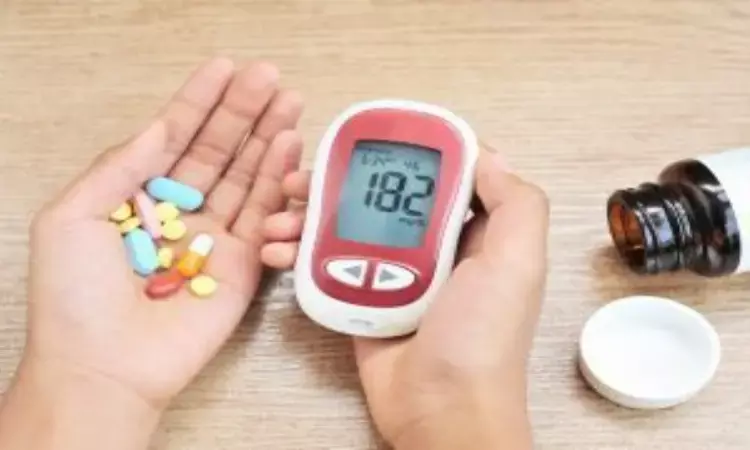- Home
- Medical news & Guidelines
- Anesthesiology
- Cardiology and CTVS
- Critical Care
- Dentistry
- Dermatology
- Diabetes and Endocrinology
- ENT
- Gastroenterology
- Medicine
- Nephrology
- Neurology
- Obstretics-Gynaecology
- Oncology
- Ophthalmology
- Orthopaedics
- Pediatrics-Neonatology
- Psychiatry
- Pulmonology
- Radiology
- Surgery
- Urology
- Laboratory Medicine
- Diet
- Nursing
- Paramedical
- Physiotherapy
- Health news
- Fact Check
- Bone Health Fact Check
- Brain Health Fact Check
- Cancer Related Fact Check
- Child Care Fact Check
- Dental and oral health fact check
- Diabetes and metabolic health fact check
- Diet and Nutrition Fact Check
- Eye and ENT Care Fact Check
- Fitness fact check
- Gut health fact check
- Heart health fact check
- Kidney health fact check
- Medical education fact check
- Men's health fact check
- Respiratory fact check
- Skin and hair care fact check
- Vaccine and Immunization fact check
- Women's health fact check
- AYUSH
- State News
- Andaman and Nicobar Islands
- Andhra Pradesh
- Arunachal Pradesh
- Assam
- Bihar
- Chandigarh
- Chattisgarh
- Dadra and Nagar Haveli
- Daman and Diu
- Delhi
- Goa
- Gujarat
- Haryana
- Himachal Pradesh
- Jammu & Kashmir
- Jharkhand
- Karnataka
- Kerala
- Ladakh
- Lakshadweep
- Madhya Pradesh
- Maharashtra
- Manipur
- Meghalaya
- Mizoram
- Nagaland
- Odisha
- Puducherry
- Punjab
- Rajasthan
- Sikkim
- Tamil Nadu
- Telangana
- Tripura
- Uttar Pradesh
- Uttrakhand
- West Bengal
- Medical Education
- Industry
Newer Second-Line Diabetes drugs increase cirrhosis risk in diabetes patients: Study

USA: The use of newer second-line glucose-lowering drugs (GLDs) versus thiazolidinediones (TZDs) is associated with a mildly elevated cirrhosis risk, suggests a recent study in the Journal of Diabetes and Its Complications. Newer GLDs include DPP4 inhibitors, GLP1RA, and SGLT2 inhibitors.
Type 2 diabetes (T2D) is known to accelerate the progression of chronic liver disease to cirrhosis, despite this, there is no knowledge on the effects of the most GLDs on cirrhosis risk in T2D. To address this gap Jeff Y. Yang, Gillings School of Global Public Health, University of North Carolina, Chapel Hill, NC, and colleagues compared cirrhosis risk following initiation of newer second-line GLDs vs. TZDs, which improve histology in non-alcoholic fatty liver disease.
The researchers estimated crude incidence rates (IRs) and propensity-score adjusted hazard ratios (aHR) for incident cirrhosis using the US Medicare Fee-for-Service database (2007-2015) and an active comparator, new-user design. They compared newer GLDs (dipeptidyl peptidase-4 inhibitors (DPP4i), glucagon-like peptide-1 receptor agonists (GLP1RA), and sodium-glucose co-transporter 2 inhibitors (SGLT2i)) vs. TZDs.
Also Read: DPP-4 inhibitors use not linked to pneumonia in diabetics, says study
Key findings of the study include:
- Among 236,549 total initiators, we observed 318, 151, and <30 cirrhosis events when comparing DPP4i vs. TZD, GLP1RA vs. TZD, and SGLT2i vs. TZD, respectively.
- IRs ranged from 1.7 to 3.6 events per 1,000 person-years.
- Point aHR estimates for cirrhosis were elevated among newer GLD initiators vs. TZD (DPP4i: 1.15, GLP1RA: 1.34, SGLT2i: 1.16), although estimates were imprecise due to short durations of drug exposure.
"We observed mildly elevated cirrhosis risk with newer glucose-lowering drugs
vs. thiazolidinediones; however, uncertainty remains due to imprecise and statistically non-significant effect estimates. So, these findings need to be confirmed with subsequent studies," concluded the authors.
Also Read: Proton pump inhibitors may increase fracture risk in men with cirrhosis, finds study
The study, "Newer second-line glucose-lowering drugs versus thiazolidinediones on cirrhosis risk among older US adult patients with type 2 diabetes," is published in the Journal of Diabetes and Its Complications.
Dr Kamal Kant Kohli-MBBS, DTCD- a chest specialist with more than 30 years of practice and a flair for writing clinical articles, Dr Kamal Kant Kohli joined Medical Dialogues as a Chief Editor of Medical News. Besides writing articles, as an editor, he proofreads and verifies all the medical content published on Medical Dialogues including those coming from journals, studies,medical conferences,guidelines etc. Email: drkohli@medicaldialogues.in. Contact no. 011-43720751


